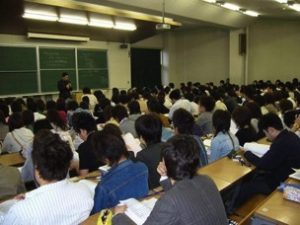Regardless of which method you choose, if you engage in these activities and have them discuss the same theme again, the quality of the discussion will improve dramatically.Or, of course, it goes without saying that one or more of these three activities may be performed in advance before participating in the discussion.
By the way, another question that I often get when it comes to providing knowledge is, "Unlike the case of a small number of people like a seminar, AL may be difficult in a large classroom lecture."For example, the thought that it may be difficult to have discussions, debates, or presentations by students in a lecture of 300 people seems to be the background of such a question.As I have experienced, it is true that discussions in lectures by 300 people can be out of control (and above all, there are protests from other classrooms due to too much noise). ..Well, what should we do?
If AL is regarded as "a general term for teaching and learning methods that incorporate the active participation of learners in learning" as defined by the Ministry of Education, Culture, Sports, Science and Technology, what we teachers should devise is how to escape from the one-way lecture format. It will be all about doing it.Specific methods for this include writing impressions and reports in each lecture, conducting quizzes based on the content of the previous lecture, taking time to make it easier to ask questions, and devising the content of the lecture. There are many ways to ask students questions over and over again during a lecture.
In addition, it is necessary to stick to how to deepen these ideas.For example, in some cases, you simply write an impression and end it, or you can take up the content of the impression in the next lecture and use it as a teaching material (or give a compliment such as "It's a good point of view". It can be used as a material to increase the motivation of the students), and if the students' understanding level is low in the quiz, it can be revisited the next time.Alternatively, it may be possible to provide an opportunity for students to deepen their thinking by commenting and returning questions / questions to the submitted impressions.In any case, if the students can not only formally perform some kind of activity but also devise ways to increase the degree of participation of the students in the lectures, it is possible to have as many ALs as possible even in a large number of lectures.In that sense, active teaching, which was mentioned in my manuscript (“Why active learning does not work”), is important for improving the quality of AL.
Also, many faculty members who are starting to work on AL seem to be worried that "all" of the lecture should be "active" when incorporating AL into the lecture.However, of course, there is no need to do so, and the author's view is that AL is successful if it can encourage students to participate in the most suitable way, considering the learning and learning effects of the students. be.
Series "Problems and solutions in the effectiveness of active learning"
XNUMXst:How to choose an active learning theme
The second:Is lecture required for active learning?
The third:How to do active learning for less motivated students
The fourth:Difficulty of evaluation in active learning
- 1
- 2



